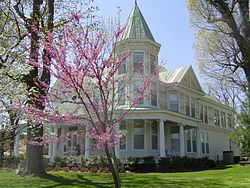Built 1845 Area 80 ha Nearest city Appomattox | Opened 1845 Added to NRHP 16 May 2002 Architect Charles M. Robinson | |
 | ||
Architectural style Mid 19th Century Revival, Late Victorian Part of Appomattox Historic District (#02000510) | ||
Room tour my nebraska house
The Nebraska House was the nineteenth century residence of Colonel Samuel D. McDearmon and his wife Mary Frances Philadelphia (Walton) McDearmon. They had it built for them in 1854. It is registered in the U. S. National Register of Historic Places in 2002 as a contributing property as part of the Appomattox Historic District of Appomattox, Virginia.
Contents
The above color pictures are of the interior of the Nebraska House as of 2004.
Room tour my nebraska house
History
McDearmon went into bankruptcy in 1853 due to failures of his business dealings in his Clover Hill properties and other investments. Since the railroad was not going to have a depot stop in Clover Hill, as once was anticipated, that pretty much put the nails into the coffin as far as his village investments went. His land and business investments depended upon the railroad routing through the little village of Clover Hill.
McDearmon made up a "bankruptcy deed" that took up eight ledger pages that consisted of his properties. The trustees for the bankruptcy were his brother and brother-in-law. After a small commission for services they were to sell his properties for whatever the market would bring to settle his debts. The deed however had some exceptions. In the day before bankruptcy protections, his wife "refused to relinguish her right of dower" in his estate. He quitclaimed large valuable properties over to her name claiming to clear the titles of the remaining properties to sell off to pay creditors. By this process he was effectively reduced to owning nothing and having no debts. His wife however, was quite wealthy due to her "dower rights".
By the fall of 1854 the trustees for McDearmon's bankruptcy decided that his properties would at that time receive the maximum amount they could and advertised a sale on October 5, 1854. In this process the debts were settled and McDearmon's wife wound up with some 500 acres (2.0 km2) near the vicinity of the new depot station located 3 miles (4.8 km) west of Clover Hill. He no longer could own property since it would be taken from him to settle his debts. His wife, however, could own property without jeopardy of losing it. Some say she retained her wealth through "dower rights," while others say it was because of her husband's clandestine and shady business practices.
The Appomattox history shows that McDearmon wanted to sell everything and move out west. The McDearmon couple gathered up their possessions at Clover Hill and started their venture west not knowing exactly where they were to wind up. McDearmon himself wanted to go to Nebraska, his wife Texas; he having relatives in Missouri while her sister Virginia (Walton) Nowlin (1825–1906) had recently moved to Texas. They relocated near the Appomattox Station, where they took up residence in a plain and modest six-room Virginia farmhouse some one hundred yards away. The house was eventually named the "Nebraska House" and the small town where the train stopped became officially the post office designation of Nebraska McDearmon's wry acknowledgement that he had stopped short of getting to his goal of Nebraska.
After McDearmon died in 1871 the "Nebraska House" was acquired by John R. Atwood who had been a clerk in McDearmon’s store in the small village of Nebraska, Virginia. Atwood died in 1912 and his wife moved out and went back to Richmond where she lived when she was young before their marriage. Later, in 1925 she sold the house to C.S. McDearmon (1871–1956), a grandson of the original owner, therefore returning it to the McDearmon family. The house then remained in the McDearmon family until it was purchased in 1993 by a retired airline pilot.
Description
The original house the McDearmons had constructed was a 2-story structure consisting of six rooms which is the back part of the present house. It presently is a 2 1⁄2-story Victorian masion. Atwood and his wife remodeled the residence in 1872 with major improvements after their acquisition of the house. It then became a Queen Anne Style architecture style, popular in the nineteenth century. Sometime after 1896 the house went through another remodel with the columns, porch rails and gingerbread trim replaced with fluted columns. This gave the outside of the house a Greek Revival architecture style appearance.
There is a 3-story turret on the northeast corner of the house. It has a ten-bay wraparound porch with fourteen fluted Ionic columns. The front main entrance, constructed after 1896, has a Roman temple appearance that is different on each side.
The above color pictures are of the interior of the Nebraska House as of 2004.
